Music in the Metaverse: Cultural Evolution and Impact
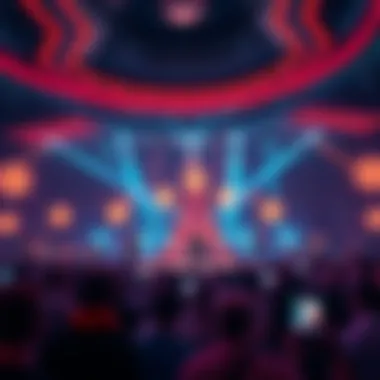
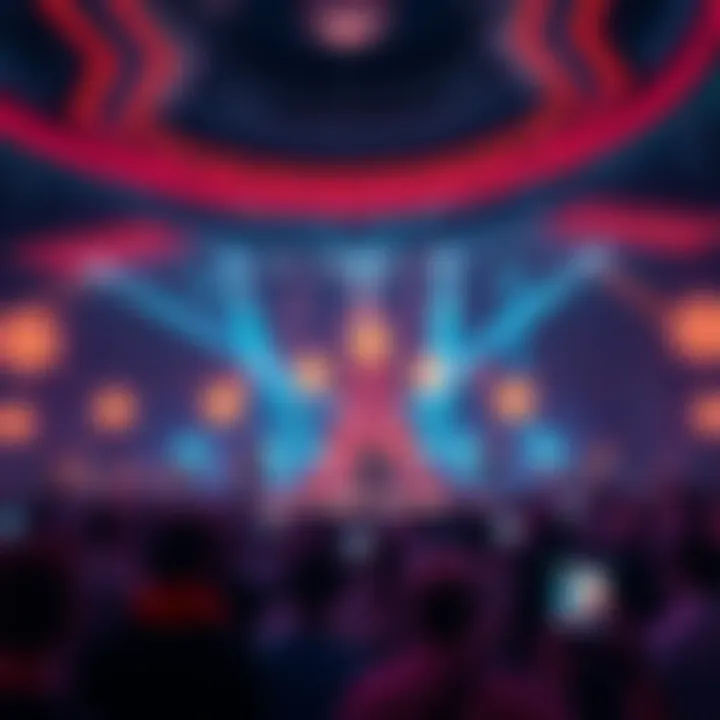
Intro
The world is rapidly evolving, and so is the way we experience and create music. In the realm of virtual interactions—akin to a massive digital playground—the metaverse emerges as a new frontier. This space is not only changing how people connect but also how they consume and produce music.
With the intersection of these two dynamic fields, artists are presented with a canvas unlike anything encountered before. Livestream concerts in virtual reality, NFTs representing unique sounds, and immersive soundscapes are just a few elements defining this unique relationship. As we dive into the intricacies of music's role within the metaverse, we shall unpack the myriad opportunities and challenges that artists and enthusiasts face in this brave new world.
What does it mean for a musician to perform in a metaverse? How are new technologies reshaping distribution channels? We aim to unveil these questions and more. Stay tuned as we take you on this fascinating journey.
Crypto Insights
Understanding Market Trends
With the metaverse yielding fertile ground for digital commerce, the intertwining of music and cryptocurrency is an area to explore deeply. Artists and musicians are now accepting cryptocurrencies as payment, pushing the boundaries of traditional finance.
The rise of decentralized finance (DeFi) in the metaverse is paving the way for artists to monetize their work better than before.
Trend analysis shows that as more artists jump on the crypto bandwagon, the market for music-related NFTs continues to grow. These tokens not only represent ownership but also ensure artists receive a significant portion of the proceeds from resales. Market trends indicate a surge in popularity among platforms like OpenSea and Rarible, highlighting how musicians can tap into new revenue streams beyond album sales.
- Rarible: Platform focused on community governance.
- OpenSea: Another leading marketplace for digital goods.
That said, understanding these market trends is crucial for artists looking to navigate the sometimes murky waters of the cryptocurrency space. Engaging with these insights allows artists to seize the opportunities presented by a volatile market while being prudent about risks.
Analyzing Price Fluctuations
In the vibrant ecosystem of music and the metaverse, price fluctuations can be a double-edged sword. The rapid changes in the value of cryptocurrencies can create both excitement and apprehension among artists. One day, a particular song's NFT can sell for thousands, only for the value to nosedive the next day. This volatility necessitates a deeper understanding of market behavior.
For musicians to safeguard their interests, they should keep abreast of market conditions. Utilizing tools like CoinMarketCap or CoinGecko can provide valuable insights on price trends and fluctuation histories. Here are a few key factors to monitor:
- Market Sentiment: News and events can swing prices rapidly.
- Regulatory Changes: New laws can affect market stability.
- Technological Advancements: Innovations can dramatically change demand.
Overall, a keen analysis of price fluctuations will help artists make informed decisions, ensuring they don’t just ride the wave but rather surf it competently.
Educational Resources
Beginner's Guides to Cryptocurrency
For those artists or enthusiasts new to the world of cryptocurrency, a plethora of resources is available to help one get started. Websites such as CipherTrace and Blockgeeks provide invaluable beginner’s guides that can break down the complexities of cryptocurrency in simple terms. Learning the lingo and understanding how wallets, exchanges, and blockchain technology work are essential steps.
Advanced Blockchain Concepts
For those who wish to delve further, understanding advanced concepts such as smart contracts and decentralized applications is crucial. Websites like Ethereum.org offer extensive resources and tutorials meant for those looking to enhance their knowledge beyond the basics. Getting familiar with these advanced concepts will not only keep artists ahead of the curve but may also create additional opportunities for innovation in the metaverse.
Understanding the Metaverse
In the realm of digital innovation, understanding the metaverse emerges as a crucial foundation for exploring how music interacts within this new landscape. The metaverse, a blend of virtual reality, augmented reality, and the internet, creates immersive experiences that redefine how users interact with not only content but also each other. This section will underscore the significance of grasping the metaverse, revealing essential facets that inform not just the music industry but also broader cultural and social dynamics.
Defining the Metaverse
The metaverse can be characterized as an expansive digital universe where physical and digital realms merge. It is not merely a single space but encompasses a multitude of interconnected environments, often experienced via avatars in virtual worlds. Key to this is being aware that the metaverse is still in its infancy, continually evolving as technological advancements unfold. Here are some defining features:
- Interactivity: Users aren’t just passive observers; they engage with their surroundings, influencing the experience.
- Persistence: Unlike typical video games or sites that reset, what happens in the metaverse remains. It is a continuous world that can reflect changes over time.
- User-generated Content: Users can create and modify elements within the metaverse. This capability empowers creatives, particularly musicians, to establish unique environments.
Historical Context
When looking back, the conception of the metaverse can be traced to various technological and cultural milestones. Early iterations of digital spaces, reminiscent of today's metaverse, stemmed from multi-user dungeons (MUDs) in the 1970s. These early online experiences laid the groundwork for communities that could share, create, and interact in real-time. The following developments marked significant shifts towards today's metaverse:
- Rise of the Internet: The 1990s brought a global, decentralized framework that allowed disparate communities to connect.
- Virtual Worlds: Platforms like Second Life crafted virtual environments where users could engage in myriad activities, thus demonstrating the commercial viability of digital interactions and social engagement.
- Advancements in VR and AR Technologies: In the 2010s, improved hardware and software began paving the way for the immersive experiences we now associate with the metaverse.
Current Trends
Today, we are witnessing an explosive growth of the metaverse, with several current trends leading the charge. To no one's surprise, the intersection of music and the metaverse is spurring novel business models and fan engagement strategies. The key trends include:
- Decentralization: New platforms, built on blockchain technology, are emerging to give artists more control over their creations and revenues.
- Experiential Marketing: Brands are eagerly diving into metaverse events, with music festivals in virtual spaces gaining in popularity, blurring lines between commerce and culture.
- NFT Integration: Musicians are utilizing Non-Fungible Tokens to sell unique digital assets, transforming how ownership and authenticity are perceived.
"The metaverse is not just a digital space; it’s a new social fabric where music and culture will thrive together."
Understanding these facets is not just an academic exercise, but a necessity for anyone looking to navigate or invest in this emerging landscape. Whether for music enthusiasts or savvy investors, deciphering the complexities of the metaverse provides a framework for appreciating its burgeoning impact on our interactions and experiences.
The Role of Music in Digital Environments
The interplay between music and digital environments is becoming a cornerstone of modern interaction. As digital spaces evolve, music finds its place, crafting a vital role that encapsulates experiences that go far beyond mere sound. This section delves into how music works in various digital settings, particularly in the regard to interactive experiences, atmosphere formation, and social engagement. By illuminating these aspects, we can derive the benefits, challenges, and considerations that arise when music integrates with digital worlds.
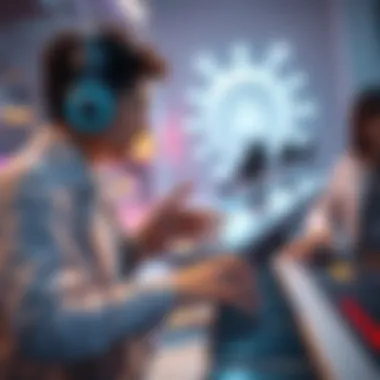
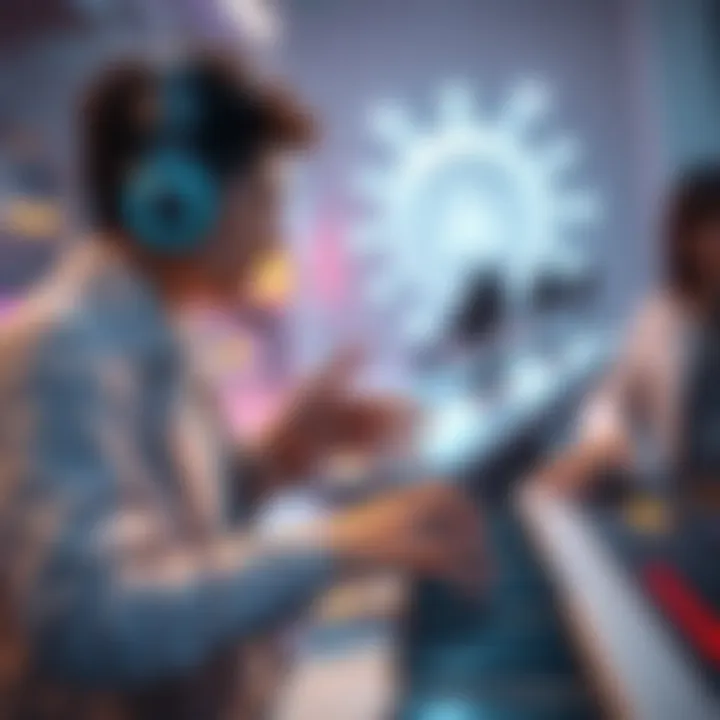
Interactive Experiences
Music has an uncanny ability to create dynamic interactions, acting as a catalyst in digital realms. Within online platforms, whether it’s a virtual reality concert or a gaming environment, the way music responds to user actions shapes the overall experience. For instance, when characters in a game level up, corresponding music changes can enhance the feeling of accomplishment. This interaction can elevate standard game mechanics into immersive experiences, making players feel genuinely engaged.
Imagine stepping into a virtual venue where the tempo of the music picks up as the crowd becomes more energetic. This feedback loop engages users deeply, like the pulse of life coursing through the experience. It’s almost like a dance between the user and the environment, where each note and beat contributes to a sense of presence.
Some successful examples include brands like Fortnite, which have famously embraced music to draw in crowds for unique events. Franklin Templeton’s “The Edge” utilizes curated playlists that adapt based on user choices, steering the narrative with sound. This integration highlights that in a world where interaction reigns king, the right music can turn a standard digital environment into a memorable spectacle.
Creating Atmosphere
Creating a specific atmosphere is essential in solidifying the identity of any digital space. The right tunes can transform a lifeless environment into a vibrant one. In the metaverse, music can signal shifts in mood or theme, conveying data through emotion when visuals might not suffice. From soothing soundscapes that foster relaxation to uptempo beats that energize, music influences emotional responses, guiding users on their journey.
Consider virtual art galleries where ambient tracks complement visual aesthetics. Through auditory stimuli, visitors may experience an increased appreciation for the art displayed. The blend of sights and sounds paves a path for a holistic experience, leading to deeper engagement. Furthermore, music can act as a temporal reference—deciding whether a space feels timeless or tied to certain trends.
"Music is the shorthand of emotion." — Leo Tolstoy
In the metaverse, this shorthand plays an essential role, especially as developers seek to detail emotional resonance beyond visual storytelling. Engaging with sound can solidify memory and brand recognition, influencing the user's return to a virtual space. So much more than background noise, music becomes a key signature element, blending seamlessly with the digital canvas.
Social Connectivity
Social connectivity is increasingly pivotal in today’s digitally-fluid landscape. Music functions as a communal bond—uniting individuals with shared tastes and experiences. As communities emerge in virtual spaces, music acts as a common thread, knitting together users who may never cross paths in real life.
Take platforms like Roblox, where users collaborate to create their unique game experiences. Enabling them to incorporate their preferred music fosters identity within those spaces. Social events or gatherings within these environments often highlight live performances, creating a social buzz that resonates within and outside the metaverse. Here, followers can interact with artists, break barriers, and form connections, nurturing a sense of belonging.
On the flip side, while connectivity breeds inclusivity, it can also highlight disparities in access. Discussions on music accessibility, ensuring everyone can partake in these shared experiences, are paramount. Whether it’s a virtual rave or a collaborative jam session, ensuring diversity translates into inclusiveness remains a challenge that music in the metaverse must navigate.
In summary, music is not just ambient sound—it's an integral part of shaping digital environments. From engaging users in layers of interactivity to enhancing social bonds, its role can’t be underestimated. As we move through these digital spaces, the continued integration of music will likely resonate in unforeseen ways, forging paths for new experiences and connections in virtual landscapes.
Music Distribution in the Metaverse
Understanding music distribution in the metaverse is a pivotal aspect of the ongoing transformation within the music industry. As artists and creators seek new avenues to reach their audiences, the metaverse serves as a fertile ground for innovative distribution methods. The significance of this topic extends beyond mere logistics; it fundamentally reshapes how music is consumed and appreciated in digital worlds. With the advent of new platforms, decentralization, and novel technologies like NFTs, the possibilities for musicians are growing immensely.
New Platforms for Distribution
The landscape of music distribution is experiencing a paradigm shift. Traditional platforms are becoming just one part of a broader ecosystem that encompasses virtual reality spaces, augmented worlds, and social hubs. Musicians can now utilize platforms like Roblox and Second Life, where they can perform live shows or share their music in immersive environments. Artists are finding ways to monetize their work directly, bypassing intermediaries often laden with hefty fees. These platforms foster a direct connection between the artist and the audience, creating unique experiences that blur the lines between creator and consumer.
- Advantages of New Platforms:
- Direct Engagement: Artists can interact with fans in real-time, receiving feedback and cultivating community.
- Global Reach: No longer confined by geographic boundaries, musicians can tap into diverse audiences around the globe.
- Innovative Revenue Streams: From ticket sales to virtual merchandise, the ways to earn are evolving rapidly.
Decentralization and Blockchain
Decentralization is a transformative element of how music is distributed in the metaverse. The use of blockchain technology allows for a more democratic approach to music sharing, enabling artists to retain greater control over their works. This can help mitigate issues like piracy and ensure fair compensation. Through smart contracts, artists can specify how their music is used and automatically receive payments based on usage without relying on third-party services. This setup not only promotes fairness but also enhances transparency, a significant concern in the traditional music industry.
"With blockchain, there's no need for a middleman; artists can engage directly with their audience."
- Key Benefits of Decentralization:
- Ownership Control: Artists maintain ownership of their intellectual property, safeguarding against exploitation.
- Transparent Royalties: Clear tracking of usage ensures fair payment distributions.
- Community Support: Fans can contribute directly to the success of their favorite artists through platforms that support decentralized models.
Incorporating NFTs
NFTs, or non-fungible tokens, have entered the music ecosystem as game-changers for distribution and ownership. With the ability to represent unique digital creations, artists can sell everything from singles to album art as collectibles. This enables fans to invest in their favorite musicians on a deeper level.
The integration of NFTs in music offers not just a method of distribution but also a new way to market oneself. Artists can create limited editions of their work, which can drive scarcity and encourage investment from fans. Additionally, each NFT can contain the artist’s entire story—an origin tale, behind-the-scenes footage, or even exclusive tracks, further engaging fans.
- Benefits of Incorporating NFTs:
- New Revenue Streams: Artists can sell their work in distinctive formats that can also appreciate in value.
- Fan Ownership: Supporters can own a piece of their favorite artist's work, fostering a sense of loyalty and community.
- Mark of Authenticity: NFTs verify the ownership and authenticity of music, providing artists with proven revenue avenues.
Artist Experiences in the Metaverse
As the metaverse continues to expand, it opens new realms for music artists, reshaping the way they create, perform, and interact with their fans. The importance of artist experiences in the metaverse cannot be understated; they are fundamentally redefining the music landscape and creating pathways for personal expression and community engagement. The metaverse serves as a stage where creative boundaries are pushed, allowing artists to reach global audiences in immersive ways that were once inconceivable.
Virtual Performances
In the metaverse, the concept of a concert transcends the physical barriers of traditional venues. Virtual performances have gained traction, offering artists unique avenues to showcase their talent. For instance, renowned artists like Travis Scott and Ariana Grande have held virtual concerts within massive online gaming platforms. These events have seen participation levels that dwarf even the largest physical crowds, enabling an unparalleled connection with fans.
– Immersive Capabilities: Virtual environments can enhance a performance, integrating 3D visuals, light shows, and interactive elements tailored for the audience. Notably, a performance in the metaverse has the potential to meld genres, giving artists liberty to explore new sounds freely.
– Global Reach: Without the need for physical proximity, artists can connect with fans from different corners of the globe. It’s a chance for emerging musicians to gain visibility and share their craft without incurring the hefty costs tied to touring.
While there’s immense potential, artists must remain cautious about the technological requirements and explore what works best for their style and audience. This blend of music and technology creates an environment ripe for experimentation.
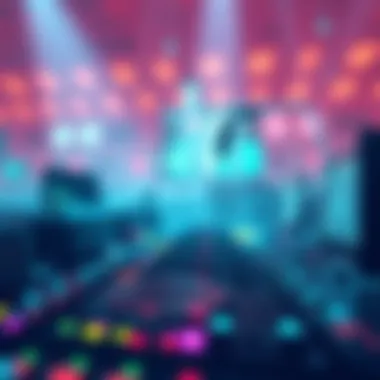

Collaborative Projects
The metaverse offers fertile ground for collaborative projects that bring together artists who may never meet in the physical world. For example, musicians from distant locations can create music together in real-time, breaking down geographical barriers. This type of collaboration can also extend to visual artists or game designers, fostering a multidisciplinary approach.
- Creativity Unleashed: When artists collaborate in the metaverse, they can leverage tools that allow for real-time feedback and collective churning of ideas, breaking traditional workflows. This could produce mash-ups, innovative genres, or multimedia projects that explore new storytelling concepts.
- Joint Ventures with Brands: Brands looking to tap into the metaverse are increasingly partnering with artists for co-branded experiences, which can amplify exposure and monetization opportunities. Such partnerships can leverage the unique aspects of the metaverse to enhance branding messages through interactive experiences.
Despite these opportunities, artists should ensure that the ventures are not exploitative and maintain creative integrity. The right partnerships are those that resonate with the artist's vision and values.
Building Fan Engagement
One of the most exciting aspects of the metaverse is the ability for artists to foster deeper connections with their fans. Traditional fan engagement often feels one-sided, but the metaverse allows for interactive dialogues.
- Interactive Spaces: Through the creation of virtual worlds, artists can host exclusive meet-and-greets, Q&A sessions, or behind-the-scenes tours. Engaging with fans in ways that are not achievable in the real world creates a sense of exclusivity that is highly prized.
- Building Community: Engaging with fans in shared spaces can also create communities around the artist. These communities can be built through forums, events, or social activities that go beyond music; they can include gaming, art, and even activism.
"The metaverse gives artists the tools to build communities that further their brand while allowing fans to be active participants rather than passive listeners."
However, while building engagement, artists should be wary of overstepping privacy issues and ensuring a secure environment for their fans.
In sum, the artist experiences within the metaverse are not just about creating music; it's about creating narratives, building communities, and exploring the vast possibilities that digital landscapes offer. This evolution promises to change the music landscape profoundly, beckoning artists to harness their creativity in ways they’ve never dreamed.
User Engagement and Community Building
Engagement with users and the creation of community in the metaverse is fundamental for the grassroot growth of the music industry within digital spaces. It's not just about putting music out there; it’s about fostering connections that bring people together in a shared virtual experience. This interaction is immensely beneficial—not only for artists and creators but also for fans, as it leads to lasting bonds and a vibrant culture. To create ways for fans to engage, artists must think outside the box, crafting experiences that resonate with their audience.
Creating Communities
In the virtual realm, communities can be formed around genres, artists, or even specific songs. These groups thrive when a sense of belonging is present. For example, a musician might set up a Discord server inviting fans to join discussions, share art, or suggest song ideas. This approach not only strengthens the relationship between the artist and their fans, but it also allows fans to interact with each other.
With community engagement, listeners are more likely to feel they have a stake in the artist’s journey. When they attend a live-streamed concert, the sense of connection to the wider community can enhance the experience significantly.
Notable practices for building communities includes:
- Hosting regular Q&A sessions or live chats where fans can directly interact with artists.
- Creating exclusive content or behind-the-scenes glimpses that incentivize community membership.
- Offering collectible digital items—like virtual stickers or badges—that fans can earn by participating.
Event Participation
Events in the metaverse have transformed how music is experienced. Unlike traditional venues, virtual spaces can host vast audiences without the limitations of physical locations. A great example lies in massive live events like Travis Scott's performance in Fortnite, where hundreds of thousands joined in to enjoy the show simultaneously. Each participant did not simply watch; they experienced it collectively, engaging not just with the music but also with one another, redefining what it means to attend a concert.
Event participation also leverages the power of social media platforms. Artists can promote events through Instagram Live or Facebook, creating a buzz that encourages fans to join in. Gamifying participation is also a clever strategy—offering rewards such as exclusive releases or merchandise can boost attendance rates, making fans feel they are part of something pivotal.
Shared Experiences
Shared experiences transform the listening of music into an event brimming with emotional resonance. Consider virtual listening parties where fans synchronize their playback and chat during an album drop. The unique rhythm of shared disappointment or joy can draw fans into an even deeper connection with both the artist and each other.
The act of sharing experiences can also be monumental in building nostalgia. For instance, reminiscing about intense moments from a live set or engaging in discussions about an album can recreate bonds that echo real-life connections. To harness this effectively, artists can incorporate elements like:
- Polls or questions during live streams to promote interaction in real-time.
- Community playlists compiled from fan suggestions, ensuring that each listener has a voice in how the music evolves.
- Collaborative creative projects, allowing fans to contribute and witness their influence over the output of the artist.
"In the Metaverse, it’s not only about listening to music; it’s about being part of a movement, a community where every voice matters and contributes to form lasting connections."
In the end, user engagement and community building isn't merely a marketing strategy; it's the essence of what the metaverse can offer. As these digital interactions enrich the music experience, they create new opportunities for artists and their audiences to define a culture around their love for music in unique and profound ways.
Challenges Facing Music in the Metaverse
As music finds its place in the metaverse, artists and industry stakeholders face a myriad of challenges that could shape the future of digital soundscapes. This section dives deep into several crucial issues that have emerged as the connection between music and this virtual realm becomes stronger. Sometimes, it feels like a tightrope walk, balancing creativity with legality and technology with privacy. Addressing these challenges is essential not just for artists, but for everyone involved in the evolving narrative of music in the metaverse.
Copyright and Licensing Issues
Navigating the terrain of copyright and licensing in the metaverse can be akin to walking through a minefield. With the advent of blockchain and decentralized platforms, the lines have blurred around how music rights are assigned, shared, and protected. In a virtual environment, during concerts or performances, the question often arises: who owns the rights to a remix or a cover with digital enhancements?
- Complexity of Rights: Unlike traditional platforms where rights are typically clear-cut, the metaverse allows for many layers of interaction, complicating ownership. Artists might be unaware of how their works can be used or misused in these digital landscapes.
- Need for Innovation in Licensing: As new technologies emerge, so do the channels for licensing. Clear frameworks are necessary to enable artists to protect their work while encouraging collaboration. This might involve rethinking existing models and adapting to the unique attributes of the metaverse.
A well-thought-out approach here is critical, as issues of intellectual property misuse could weaken trust in the very platforms aiming to support artists.
Quality Control
When diving into the rich pool of creativity present in the metaverse, quality can sometimes take a back seat. With the ease of creating and distributing music, the barrier to entry for artists is lower than ever, and while that sparks innovation, it can also dilute the overall quality of music.
- Curating Experience: Metaverse platforms must take the responsibility of ensuring that only quality content is highlighted. Without proper curation, users could easily be overwhelmed by the sheer volume of mediocre or subpar works.
- User Expectations: Audiences, especially seasoned music fans, have certain expectations. They often seek immersive experiences. If the quality of music does not meet those expectations, it may lead to disengagement or dissatisfaction with the platform itself.
As such, establishing standards for the quality of music in the metaverse is not just a technical challenge but also a cultural one.
User Privacy Concerns


In the digital age, user privacy is much more than just a buzzword; it is a pressing concern that influences how music is consumed and shared in the metaverse. As platforms gather data to create personalized experiences, the balance between personalization and privacy can become precarious.
- Data Collection Practices: Many platforms may depend heavily on user data to tailor music recommendations or events. However, not all users are comfortable with such extensive data tracking. It raises the question: how much are users willing to give up for a captivating experience?
- Building Trust: To ensure that users feel secure while interacting with the music, platforms must be transparent about their data use. Developing clear privacy policies and user agreements can help build trust, but it's imperative that these policies are not just words on a page. They should reflect a genuine commitment to protecting user privacy.
As music and technology continue to intertwine, addressing these user privacy concerns will be vital for fostering an engaged and loyal user base.
In summary, the journey for music in the metaverse is fraught with challenges—from managing copyright complexities to maintaining quality and ensuring user privacy. Each of these factors plays a pivotal role in shaping the future of how music is experienced within this dynamic digital ecosystem.
The Future of Music in the Metaverse
As we venture into a new epoch of digital interaction, the future of music in the metaverse is both a fascinating collaboration and a challenging frontier. This section aims to peel back the layers of how digital environments convert musical artistry into new opportunities. It focuses on emerging technologies, shifts in consumption patterns, and the continuously evolving roles of artists in this virtual landscape.
Emerging Technologies
Technology is the heart and soul of the metaverse, paving new pathways for creativity and engagement. Several innovations are presently transforming how we experience music. For instance, virtual reality (VR) and augmented reality (AR) are connecting audiences to artists like never before. Imagine putting on a VR headset and finding yourself front-row at a concert, or joining friends in AR to dance around a holographic DJ spinning tunes in your living room. These technologies create immersive experiences, inviting listeners to participate, not just observe.
Moreover, advancements in artificial intelligence (AI) are enabling personalized music experiences. AI-driven algorithms can curate playlists or even compose original songs based on users' mood and preferences, greatly enhancing how we engage with music. Blockchain technology, too, is making waves, providing artists with new monetization avenues through smart contracts and secure transactions, fundamentally changing the landscape of music rights and royalties.
"The metaverse is not merely a stage; it’s an expansive realm of possibilities where music can evolve into an ever-interactive experience."
Shifts in Consumption Patterns
The way people consume music is undergoing tectonic shifts as the metaverse takes shape. With traditional platforms facing competition from decentralized networks, listeners are now exploring new forms of engagement. Subscription services, once the crown jewels of music distribution, might become secondary to experiences that combine sound with virtual communities. Listening habits have changed; we no longer just stream songs while driving or working. We seek a full experience -- from virtual events to collaborative jam sessions.
As consumer behavior changes, artists have to adapt. Streaming has nudged many towards shorter releases, like singles, which align well with attention spans in fast-paced environments. While this precision ensures airplay, it leaves deeper musical exploration on the back burner. Yet, in the metaverse, listeners have the potential to delve deeper, exploring entire albums through curated experiences centering on storytelling or emotional engagement, differentiating the act of listening from mere consumption.
Evolving Artist Roles
In this changing landscape, artists are not just creators anymore; they are multifaceted operators navigating through various platforms and mediums. The metaverse is demanding that musicians wear multiple hats as they engage in branding, community-building, and content creation. With followers scattered across the digital realm, musicians need to create their own unique virtual spaces where fans can connect and interact with them. This could be done through tailored experiences — let’s say, hosting listening parties in a digital club atmosphere.
Being an artist today means mastering the art of social media presence, utilizing NFTs for unique offerings like exclusive tracks or behind-the-scenes access. Such shifts require an agile mindset, where adaptability is the name of the game. With the pace of technological advancement, the role of the artist will likely transform further, pushing boundaries and expectations.
Case Studies of Successful Integration
Understanding the practical applications and implications of music within the metaverse is crucial. It illustrates how artists and creators utilize this virtual space effectively. Examining case studies provides concrete examples, showcasing the blending of technological innovation and artistry. Not only does it highlight successful ventures, but it also sheds light on the factors contributing to their accomplishments while offering insights for future endeavors.
Notable Virtual Concerts
Virtual concerts have proven to be a striking feature of the metaverse, attracting large audiences across global platforms. One of the standout examples is the 2020 performance by Travis Scott in Fortnite. This event pulled in millions of viewers and was lauded for its immersive experience. Players could interact within the virtual world, dancing and moving alongside the animated version of Scott. The visuals and music synchronized superbly, creating an atmosphere that was not just a concert, but an experience.
Another significant case was Lil Nas X’s concert in Roblox. It provided fans not just with music but an interactive world to explore. Concert-goers could collect virtual items, interact with special effects, and even meet avatars of other fans. These concerts demonstrate how artists leverage existing gaming platforms to engage with audiences in innovative ways. They also highlight the potential for monetization through virtual merchandise and exclusive content.
"Virtual concerts redefine the way we experience music. They merge creative artistry with technology, creating immersive environments that traditional performances can’t match."
Innovative Collaborations
Collaboration within the metaverse often transcends traditional boundaries, leading to unique artistic experiences. For instance, 2 Chainz collaborated with virtual reality developers to create immersive music videos. These videos allow viewers to step into a 360-degree world, experiencing his music through perspective and interaction. This is a prime example of artists combining music and technology, tailoring their artistry to fit new platforms.
Another noteworthy collaboration is between DJ Marshmello and Fortnite, creating a new genre of live performance. This venture didn’t just rely on music; it combined visuals, gaming, and interactive socialization. Fans were sent on a quest while listening to new tracks, thus enhancing engagement beyond mere listening. In this respect, the partnership unlocked new relationships between audiences and the creative material.
Furthermore, companies are exploring collaborations with artists to create exclusive metaverse experiences. A notable example is Gucci’s partnership with 10KTY, a platform that integrates art, fashion, and music. This collaboration merges various cultural elements, breaking traditional barriers and allowing enhanced engagement in the digital realm.
Through these collaborations, we see a reimagining of artistry and community that was once dormant in traditional venues. Artists tap into the metaverse's limitless potential, paving ways for new connections and interactions.
As more artists turn their focus to the metaverse, examining these case studies will provide invaluable insights for others looking to invest time and resources in this evolving digital landscape.
Ending
In this digital age, the intersection of music and the metaverse is much more than a fleeting curiosity; it's a pivotal juncture brimming with potential. The integration of music into these virtual landscapes opens up new realms of interaction, creativity, and monetization. It offers fresh pathways for artists and listeners alike, making the music exploration experience not just a passive affair but rather an active and engaging journey.
Summarizing Key Insights
As we explored, several key insights emerge from the confluence of music and the metaverse:
- Transformative Interaction: Music can enhance the user experience, providing an immersive backdrop that shapes the emotional tone of virtual environments.
- Innovative Artist Engagement: Artists, through virtual performances, reconnect with fans in unprecedented ways, creating unique experiences that transcend geographical boundaries.
- Economic Opportunities through New Platforms: The rise of decentralized platforms opens diverse channels for music distribution, encouraging fairer pay structures for creators. Emerging technologies like blockchain have set the stage for a new wave of transparency in music royalties.
"The metaverse isn't just a place to exist; it’s a canvas for artists to paint their sonic masterpieces, breaking down traditional barriers and creating communities united by sound."
- Community Building: Users are finding distinct communities built around musical interests, leading to more significant interpersonal connections and shared experiences.
These insights not only highlight the novelty of the current landscape but emphasize the versatility and resilience of music in evolving digital frameworks.
Implications for the Industry
The ramifications for the music industry extend well beyond simple trends; they compel a reevaluation of its core practices. Some significant implications include:
- Shifting Business Models: Music producers and labels may need to rethink their conventional models. The demand for virtual concerts and exclusive digital releases is growing, compelling stakeholders to adapt.
- Emphasis on Digital Identity: Artists are becoming brands within the metaverse, curating their presence and engaging with consumers on different platforms. The maintenance of a robust digital identity will be crucial.
- Increased Attention to User Privacy: As data concerns grow, the industry must be vigilant. Balancing user privacy while maximizing engagement will be a key challenge.
- Experimentation with New Revenue Streams: The burgeoning avenues of revenue—ranging from NFTs to virtual merchandise—highlight the potential for artists to diversify their income.
In summary, the metaverse advances forth as a revolutionary space, one that offers not just challenges but vast opportunities for innovation and growth in the music landscape. Understanding these dynamics provides an essential blueprint for those looking to navigate and thrive in this digitized future.



